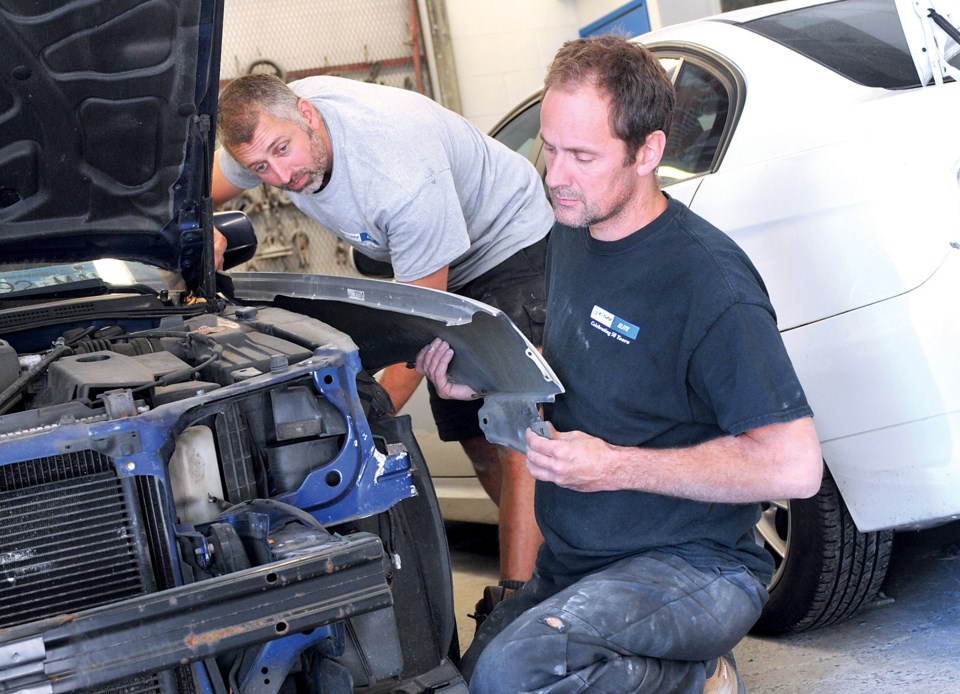The most common type of collision car repair Warren Kohlhaas deals with these days involves bumpers, both front and back.
Kohlhaas is a collision repair specialist at Elite Body Shop in North Vancouver, a body collision shop that also does light engine components and suspension.
“(It’s) a lot of scuffs, and if it’s hit any harder than that then you’ve got a broken taillight or a broken headlight,” he notes, explaining that bumpers these days are more cosmetic than they are strong. A metal rebar behind the bumper is what gives it its strength.
A lot of details have changed in the 28 years Kohlhaas has been working at Elite, including the metal used in cars. Metal work is one of his favourite parts of the job (including cutting metal and re-fabricating), and he points out that newer cars tend to contain thin metal compared to a few decades ago.
“You get cars that are (from) the ’50s, ’60s, and ’70s, that’s heavy steel. You could bang and pound that metal all day long and you’d still have lots to work with. Today’s metal is flimsy,” he says.
Newer cars can have some composite metals, full steel skin, an alloy skin, or an aluminum skin.
“There’s a lot more aluminum coming in these days,” says Kohlhaas, noting that requires a different way of doing things, and a whole new set of tools to work with because aluminum reacts with iron, so if he is using a hammer on aluminum it has to be a stainless steel hammer. He also has to use a stainless steel brush to clean surfaces before welding, etc.
“Aluminum is very finicky,” he notes.
Air bags are another complicated addition to modern cars. A positive addition, to be sure, but some cars have many airbags, and repairing the system after an accident can be quite a project.
If a car is hit on the driver’s side, for example, Kohlhass says he would have to replace the sensor on the front behind the fender, replace the airbags that blew, replace the seatbelt that was being used, change the brain module under the centre console, and sometimes take the steering wheel off and change the clock spring.
“When you do it enough you know the steps you have to take,” he says, but getting there takes time.
That’s not all that’s changed since Kohlhaas first got his start in the industry more than two decades ago. At the time, he was working in a restaurant until a friend told him about the opportunity to take over his job “pushing a broom” at an auto body shop.
Kohlhaas decided to give it a try, and the more he watched and learned, the more interested he became in the field of collision repair. Eventually he finished his four-year training and apprenticeship program at Camosun College in Victoria and worked at a couple of different auto shops until moving over to Elite 28 years ago.
Although he enjoys his work at Elite, collision repair is a tough job, and you also have to work with chemicals, although all the proper safety gear is provided.
It’s a good trade to consider, he notes, if you don’t mind getting your hands dirty. Kohlhaas takes pride in his work, but admits it’s not an easy job.
The North Vancouver father of two university-aged kids, a son who is working in the field of psychology and a daughter who is also going into health sciences, says there’s always something new to learn and, in general, cars are more complex these days and collision repair is not as straightforward as it used to be.
“Cars were easier to work on back in the ’80s and ’70s,” says Kohlhaas. “Things sort of came apart easier in different ways.”
In the past, pulling out a headlight meant loosening a couple of screws and the headlight was out. Now it’s a bigger job. “It’s a whole headlight capsule so now you have to pull the bumper off to get the headlight off,” he explains.
Headliners (roofs) are also more work now because so many cars have air conditioning, lights, vents, TVs, and other amenities in the roof, especially mini-vans. Body work in that area requires some deft skills. “They’re fragile,” says Kohlhaas of some of the new electronic components.
A lot of the new technology is great for consumers but some features cost a lot of money to repair because so many elements are involved in the damaged area and that takes more time and labour to fix.
These days, Kohlhaas drives a Chevy Cobalt and also rides a motorcycle. When asked, he says his dream car would be “probably just a nice beautiful pickup truck.”
Kohlhaas agrees that it feels good to finish a job and see a repair come together. He enjoys working with his hands and says the skills are transferable: he’s even more handy at home now thanks to the repairs he does at work. Throughout his career, he has seen many different cars rolls into the shop from a $160,000 BMW 800 series to some he admits might be better off in the scrap heap.
Elite is a family run business celebrating 50 years of service, and although a lot has changed during those years, one thing has stayed the same when it comes to doing the job right: The strategy for keeping up with the times involves continuing to learn, and as Kohlhaas suggests, “you really have to be a good mechanic.”



